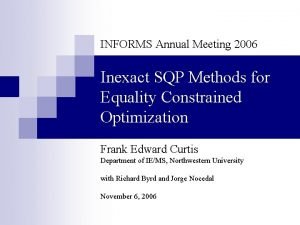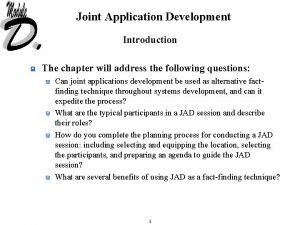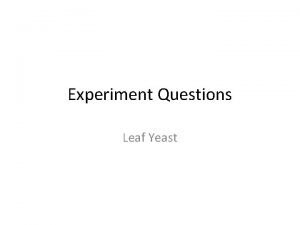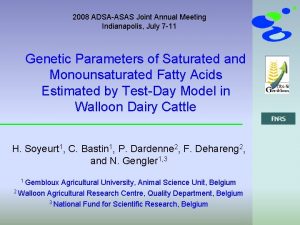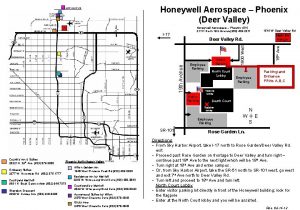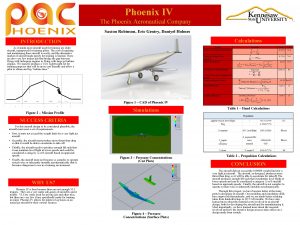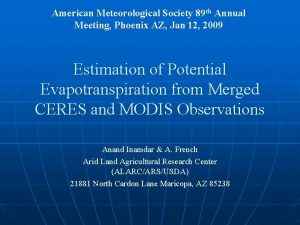2012 ADSAASAS Joint Annual Meeting Phoenix AZ July




























- Slides: 28

2012 ADSA-ASAS Joint Annual Meeting Phoenix, AZ, July 15 -19 Extension of Bayesian procedures to integrate and to blend multiple external information into genetic evaluations J. Vandenplas 1, 2, N. Gengler 1 1 University of Liège, Gembloux Agro-Bio Tech, Belgium 2 National Fund for Scientific Research, Brussels, Belgium

Introduction • Most reliable EBV if estimated from all available sources • Most situations – Multiple sources (e. g. , dairy breeds) • Traditional genetic evaluations • International second step (Interbull) Animals with few (or no) local data: low accuracy – Development of genomic selection New genomic information sources Strategies for integration / blending of those multiple external evaluations

External information • Most situations – EBV and REL from other genetic evaluations – Information not taken into account by a local BLUP No double-counting between local and external evaluations – Only available for some animals • Having, or not, phenotypic information in the local BLUP • Present in the pedigree of the local BLUP • Special case: MACE-EBV

Aim To integrate/blend multiple a priori known external information into a local evaluation Using a Bayesian approach – Based on • • • Legarra et al. (2007) Quaas and Zhang (2006) Vandenplas and Gengler (2012)

Regular BLUP • Mixed model equations – – – : Inverse of genetic (co)variances matrix : vector of local observations : vector of estimated local fixed effects : vector of estimated local EBV

Methods • Assumption: A priori known information of – n sources of external information: • n vector of external EBV • n prediction error (co)variances matrices – Issue: only available for some animals and : (partially) unknown

Methods • For each source i: Estimation of – Available: External EBV of external animals ( – Local animals: prediction of external EBV ( ) ) Predicted external EBV Available external EBV Correct propagation of external information

Methods • For each source i: Estimation of : Inverse of genetic (co)variances matrix of

Methods • Integration of n external information Sum of n least square parts of LHS of n hypothetical BLUP of n sources of external EBV Sum of n RHS of n hypothetical BLUP of n sources of external EBV

Methods • Blending of n external information – Assumption: no local records in

Methods • Issue: double-counting of information among external animals Estimation of contributions due to relationships and due to own records All only depend on contributions due to own records

Simulation: blending • 100 replicates • 2 populations – – ± 1000 animals/population 5 generations Random matings / cullings Observations (Van Vleck, 1994) • • Milk yield for the first lactation Heritability : 0. 25 – Fixed effect • Random herd effect within population

Simulation: blending • Performed evaluations Information Pedigree External population Local population + 50 external sires used locally Phenotypes External observations Local observations External information External EBV and REL (50 external sires) Local EBV and REL (all population) External BLUP ü ü Local BLUP Blending BLUP Joint BLUP

Simulation: blending • Performed evaluations Information Pedigree External population Local population + 50 external sires used locally Phenotypes External observations Local observations External information External EBV and REL (50 external sires) Local EBV and REL (all population) External BLUP Local BLUP ü ü Blending BLUP Joint BLUP

Simulation: blending • Performed evaluations Information Pedigree External population Local population + 50 external sires used locally Phenotypes External observations Local observations External information External EBV and REL (50 external sires) Local EBV and REL (all population) External BLUP Local BLUP Blending BLUP ü ü ü ü Joint BLUP

Simulation: blending • Performed evaluations Information Pedigree External population Local population + 50 external sires used locally Phenotypes External observations Local observations External information External EBV and REL (50 external sires) Local EBV and REL (all population) External BLUP Local BLUP Blending BLUP Joint BLUP ü ü ü

Comparison with joint BLUP • Rank correlations (r+SD) Evaluation Local animals External sires 0. 95 ± 0. 02 0. 54 ± 0. 11 0. 99 ± 0. 004 0. 97 ± 0. 01 >0. 99 ± 0. 000 >0. 99 ± 0. 001 Without external information Local BLUP Only external information Blending BLUP With double-counting Without double-counting Rankings more similar to those of the joint BLUP

Comparison with joint BLUP • Mean squared errors (MSE+SD) - Expressed as a percentage of the local MSE Evaluation Local animals External sires Without external information Local BLUP 100. 00 ± 26. 7 100. 00 ± 24. 5 21. 20 ± 6. 2 6. 83 ± 1. 9 0. 48 ± 0. 23 ± 0. 1 Only external information Blending BLUP With double-counting Without double-counting Importance of double-counting

Conclusion • Bayesian Mixed Model Equations Rankings most similar to those of a joint BLUP – Importance of double-counting among animals

Conclusion • Bayesian Mixed Model Equations Rankings most similar to those of a joint BLUP – Importance of double-counting among animals Bayesian procedure – Reliable integration/blending of multiple external information – Simple modifications of current programs – Applicable to multi-traits models

Special case: MACE • Integration of MACE-EBV – Genetic evaluations – Single-step genomic evaluations (cf. oral presentation at this meeting) Issue: included local information Estimation of external information free of local information:

Special case: MACE • Integration of MACE-EBV

Special case: MACE • Integration of MACE-EBV Inverse of (combined genomic -) pedigree based (co)variances matrix

Special case: MACE • Integration of MACE-EBV Inverse of (combined genomic -) pedigree based (co)variances matrix Inverse of prediction error (co)variances matrix of MACE-EBV

Special case: MACE • Integration of MACE-EBV Inverse of (combined genomic -) pedigree based (co)variances matrix Inverse of prediction error (co)variances matrix of MACE-EBV Inverse of prediction error (co)variances matrix of local EBV

Special case: MACE • Integration of MACE-EBV Inverse of (combined genomic -) pedigree based (co)variances matrix RHS of an hypothetical BLUP of MACE-EBV Inverse of prediction error (co)variances matrix of local EBV

Special case: MACE • Integration of MACE-EBV Inverse of (combined genomic -) pedigree based (co)variances matrix RHS of an hypothetical BLUP of MACE-EBV Inverse of prediction error (co)variances matrix of local EBV RHS of an hypothetical BLUP of local EBV

Acknowledgements • Animal and Dairy Science (ADS) Department, University of Georgia Athens (UGA), USA • Animal Breeding and Genetics Group of Animal Science Unit, Gembloux Agro-Bio Tech University of Liège (ULg – Gx. ABT), Belgium • National Fund for Scientific Research (FNRS), Belgium
 Nrg oncology semiannual meeting 2021
Nrg oncology semiannual meeting 2021 Grand lodge of ky annual meeting
Grand lodge of ky annual meeting Nrg oncology meeting 2017
Nrg oncology meeting 2017 Informs annual meeting
Informs annual meeting American epilepsy society annual meeting 2017
American epilepsy society annual meeting 2017 Annual theory meeting
Annual theory meeting Aashto annual meeting 2015
Aashto annual meeting 2015 Aupha annual meeting
Aupha annual meeting Cwemf
Cwemf Scts annual meeting
Scts annual meeting American psychiatric association annual meeting 2020
American psychiatric association annual meeting 2020 How to run an annual general meeting
How to run an annual general meeting Types of meeting
Types of meeting What is meeting and types of meeting
What is meeting and types of meeting For todays meeting
For todays meeting Today meeting or today's meeting
Today meeting or today's meeting Joint meeting essex and union county
Joint meeting essex and union county Jad session agenda
Jad session agenda Break joint vs spool joint
Break joint vs spool joint Luschka's joints
Luschka's joints Condyloid joint
Condyloid joint What are permanent joints
What are permanent joints Joint bank account in joint venture
Joint bank account in joint venture Lamb grading chart
Lamb grading chart Sources nso july frenchhowell neill technology...
Sources nso july frenchhowell neill technology... 2001 july 15
2001 july 15 Growth of leaf yeast experiment
Growth of leaf yeast experiment June 22 to july 22
June 22 to july 22 July 4 sermon
July 4 sermon



